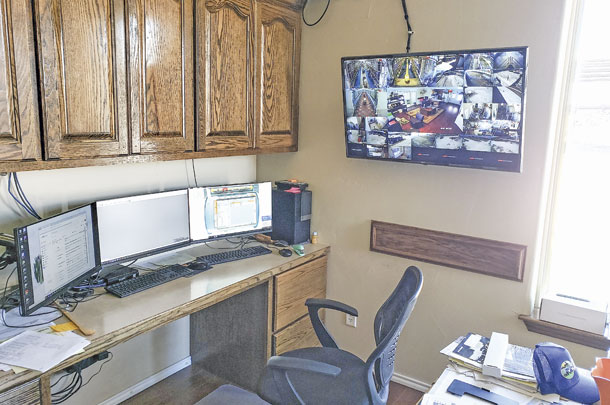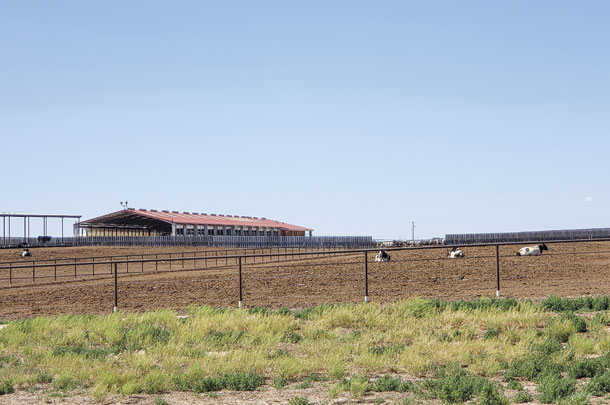That’s why Prairie View Dairy in Muleshoe, Texas, has embraced a data monitoring system.
Celebrating a 40-year history, Prairie View Dairy is one of the oldest dairy farms in the region, established in 1978 by Larry Hancock and Dan Loper. Larry moved from Arizona with his wife, Pam, to a farm of 35 Jersey cows that were sold and replaced with 300 Holstein heifers. As James Hancock, current owner, explains, as time passed Larry saw the need to grow the dairy and eventually bought out Dan and set about increasing the size of the dairy.
Through the years, the dairy expanded significantly and has seen many changes – from the production per cow to the technology implemented to the feed placed before the cow.
“The most significant of those changes are the genetics of the cattle involved,” James Hancock says. “Prairie View Dairy has always prided itself on the herd.
“The average for each individual cow has increased significantly so that more milk is being produced by fewer numbers of cows than just two years prior. And with the introduction of new technologies, growth and problems can now be traced on individual cattle rather than waiting to see an overall trend in the herd.”
The technology Hancock is referring to is the adoption of an activity and rumination monitoring system for the 4,500 cows.

“When we implemented the collar technologies, major changes were needed just to utilize it to the fullest,” Hancock says. With the collars being able to track the activity and rumination with each individual cow, a myriad of symptoms – including heats, diseases, calving, lameness, cystic, anestrus, heat stress and regular distress from outside stimulus – can be tracked and acted upon quickly and efficiently.
Of course, with any technological change comes challenges aplenty, and Hancock says changes were needed to use the system efficiently and effectively throughout his operations.
“The first thing that went to the wayside was tail chalk,” Hancock says. “For time immemorial, chalk was used to find a cow in heat and see that she was bred. So to take and tell a breeder that chalking was no longer needed and actively discouraged was sacrilegious.”
The breeders at Prairie View Dairy thought no differently. It seemed they passed through all five stages of grief in the first six months after the system was up and running. Denial was rampant, and the management had to prove the new system could outperform chalk nearly 100 times before it could be valid.
Along with the tail-chalking program, a few other things were set aside that are typically used for breeding. As Hancock explains, the Ovsynch program saw some major changes – mainly in that the start of the program was pushed back far enough so it was only relevant to a bare minimum of cattle.
“The voluntary wait period was lengthened significantly so the cow could reach higher into the peak milk before she was disturbed,” Hancock says. “Other changes are being brought out and tested, and all of that is possible because the system can track each cow individually. In the future, the breeding at Prairie View Dairy will be radically different from anything that has been seen at the farm up till now.”

While streamlined and efficient breeding practices are a significant result of the monitoring system, the improved health of the cows has proven paramount.
“In the beginning of the install for the system, health tracking was a secondary or tertiary concern,” Hancock says. “It didn’t even appear on the radar, but it did manifest itself rather quickly.”
The first sick cow list that was generated showed cows the system called “sick.” When the herdsman went and found those cows and brought them into the sick pen and began to diagnose, there was nothing there to find. The cattle were turned back into the general population, and complaints were made by the herdsman to “please not waste our time.”
“At first, the thought was something was wrong with the system – either it was way too sensitive or just nonresponsive in the way that was needed,” Hancock says. “Each list was kept, and another list was made. These were cattle the system considered critical or heavily in need of treatment. What was found was that all the cattle that came onto the critical list were also found on the original sick cow list. The system was finding the cows a full three days before the herdsman could determine if they were sick or not.”
As a result, a change was required in all the protocols for the sick cows as well as an entirely new protocol just for the enrollment and entry of cattle into the sick pen. It also necessitated a change in the lockup procedures.
“It becomes inefficient to send several people out to look at every cow to find both the sick, in heat and lame cattle when the system can identify them days before the herdsman even notices something is wrong,” Hancock says. “Now that the system has been in place for a few years, the benefits have continued to show and are expanding into other areas that were never thought of in the beginning.” Calving is one area that is being explored as well as heat stress monitoring.
As the use of the monitoring system progressed, Hancock and his team recognized there was a lack of daily milk weights tied into the collars to provide a correlation between the activity rumination and milk production.
The milking points system from SCR was chosen for the ease of interfacing with the collars, which worked well with the dairy’s specific setup procedure of utilizing three distinct barns on the farm.
As Hancock explains, all three of the barns serve a different purpose. Barn 1 is a fresh cow barn. As such, the milking points system is used as a means to determine the health and use of new fresh cows entering the herd. Also monitoring the increase in milk over the transition provides enough data to aid in how certain cattle should be treated – including feed, treatments or other needs special to the fresh or transition cow.
Barn 2 is the pregnant pre-dry barn. Here the system helps determine dry-off as well as monitoring for a fall in the production due to feed or movement. Barn 3 is the breeding barn.
“DNB (do not breed), culls, sick cows and things of that nature come naturally to the system, but there are other things that flow into the breeding program that have come up,” Hancock says. “For instance, using daily milk as a means of determining genetic selection in the breeding seems possible. There are many options to explore and attempt to utilize, but it has to all be installed and then fine-tuned. It took nearly a year before the collar system was tuned enough to find all the uses it has. The same holds true for the milking points system.”
Hancock says that with the increase in monitoring cows and seeing just how much every touch affects the routine that cow settles into it, it appears cows should be touched as little as possible.
“Hopefully, soon there will be no need for lockups or programs that need to have more cattle secured than necessary. All of these changes will continue to put pressure on the dairy industry to keep up with the technology that is being introduced,” Hancock says. “The idea is to not be first but to be ahead of the curve. We believe that technology is there to aid us in producing the best product in the world and to ensure we can do it in the best way for the cows, as they are part of our family and legacy.” ![]()
PHOTO 1: Technology application in each of Prairie View Dairy’s three barns plays a different role in a herd-wide monitoring system.
PHOTO 2: Using monitoring technology with other programs, the Prairie View Dairy team closely monitors all aspects of their herd’s health from the farm’s central office.
PHOTO 3: Using monitoring systems leads to less handling and confinement of livestock and ultimately benefits the animals. Photos by James Hancock.
Maura Keller is a freelance writer in Plymouth, Minnesota.





